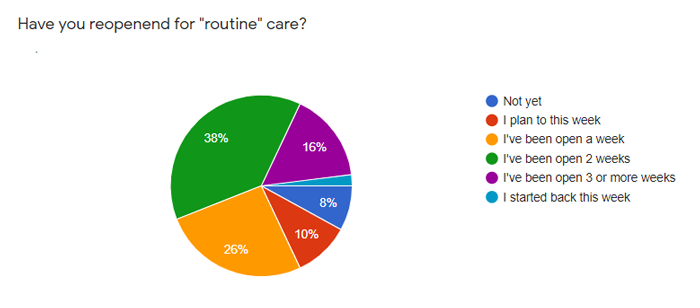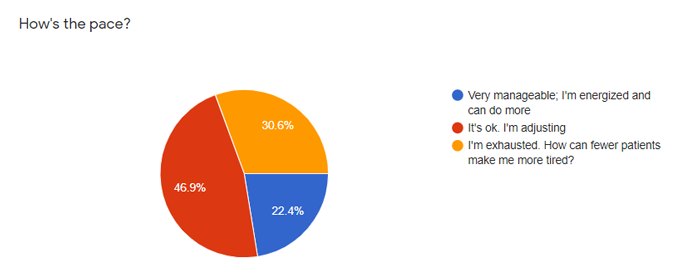

Most respondents to a late-May Women In Optometry Pop-up Poll said that they are back in practice, but it is a bit of an adjustment for many. Forty-seven percent said that the pace of being back to a more routine schedule is OK, but 31 percent said that it is exhausting with the new requirements for sanitization and the accompanying stress of keeping an office safe and clean.


Here’s what those who feel tired with the new routine say are contributing factors:
- It’s difficult to breathe through a mask: 86%
- Concerns about keeping the office sanitized: 71 percent
- Worry about staying healthy personally: 35%
- Maintaining social distancing among staff: 25%
- I miss my house/significant other/kids: 22%
- Meeting patient expectations: 18%
Others wrote in that they’re stressed about the economy generally or about business and working with fewer staff.
Even so, more than two-thirds of the respondents say that they are quite happy to be back at work. In addition, they seem pleased that patients are generally returning, ready to make purchases.


TAKING ACTION
Several respondents wrote in what they’re doing to relieve their stress and/or speed their adjustment.
- Exercise
- Scheduling at 50% and reduced hours. We are starting with 5 hours 3 days a week.
- Write out all the new protocols and reviewing them every day with staff
- We can minimize stress?
- Enjoying my home and family more.
- I am loving the slower pace. This has forced my office to do things we should have been doing for years: scheduling adjustments, dispenses, etc. A few less patients on my schedule. I have learned that you have to control your chaos. I have a private practice that I want to feel like a private practice. My husband and I have done such a good job at growing our practice, we are at the point where we need to be more selective about our patients. This pandemic has actually helped us focus on quality of patients not quantity.
- I took Friday off of patient care for the first three weeks
- Nothing. It’s more stressful. Seeing just as many patients as before.
- Devotion and quiet time, exercise
- Wine
- Adjust hours 6 hours, finish early
- 2 patients an hour
- Control the schedule
- Massages, trying not to worry too much if patients no show, delegating tasks
- Reduced patient flow
- Scheduling fewer patients per day
- Trying to keep busy
- Trying to stay in my normal routine
- Starting to play pickleball
- Keeping a positive attitude is key, which we achieve with jokes and practicing smiling with our eyes.
- Added one extra doctor day to make up for six weeks of lost revenue and higher chair cost per patient now that we are back open. Meditation. Frequent calls with optometry colleagues and closest advisors/friends
- We never fully closed and implemented protocols in stepwise fashion



